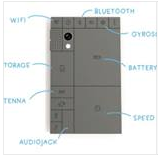While all routine and mundane tasks will eventually be relegated to software and robots, some tasks are sufficiently far off that a little short-term compromise might be necessary. One of these tasks falls in the realm of laundry. While the atomic operations of cleaning and drying have been automated for so long that the legacy manual operation is no longer even attempted by most, chaining these operations into a single compound automated system seems sufficiently out of reach. While some systems are starting to
bridge cleaning and drying, the operation that seems hopeless to automate is the dreaded folding step.
Clothing is a unique substance in that each item is made up of fibers which are solids with one key property; extreme flexibility in a single dimension. The processes of looming and stitching exploits this property and makes a three-dimensional object which has a general shape but still remains quite flexible in all dimensions. The flexible properties of clothing are what make them appealing as garments as they allow for a wide range of body sizes, shapes and motions. The flexible property is even exploited in the automated cleaning and drying steps of laundry as clothing is fluidized and agitated to encourage the respective dirt and water separations. The flexible nature of clothing is requisite for these reasons but has enabled a dark side of clothing manufacture that is diametrically opposed to and essentially prevents any efforts to automate the folding process.
Fashion dates back to
the 12th century as tailoring guilds began forming in Europe. At this point in history there was no concept of automated washing so no naturally clothes were designed with no consideration for the practice. The automated washing machine would not begin to appear for six centuries meanwhile fashion continued spiraling out of control generating garments of immense complexity. Today garments produced by high fashion defy categorization and look like nothing when not being worn.
 |
| I guess she couldn't stop chewing her leg? |
 |
| How is this a bathing suit? |
While most people won't wear the clown suits that model's wear on runways, the products of high fashion act as a north star for fashion design whereby the Old Navy's and Gap's of the world attempt to walk a fine line between practical and fashionable. Very little consideration is paid to how well these garments lend themselves to automated laundry. In fact the "north star" products mentioned above normally can't even be subjected to conventional laundry processes and instead have to be dry cleaned which is still a semi-industrial process which is not meant for the home. The bottom line is clothing is thought of a personal statement rather than the utility it is which is a detriment to its longevity and efforts to automate it's maintenance.
It is because of this that clothing manufacturers focus on how the clothing looks on a mannequin/model and then settle on what an acceptable number washes is before it disintegrates. Where does this leave automated folding? The sad state is that due to the insanity that is the fashion industry, clothing varies so much that even the best computer vision and robotics we have today (and likely will have for many years) will be confounded when that one hot skirt/body wrap/cabbage/small dog that is all the rage is picked out of the pile. The robot arms that could perform a quadruple bypass surgery on a muskrat will end up ripping a frock/sweater/ski mask/basket of muffins to pieces, the owner of the confounding garment will blame the machine and we'll have wasted everyone's time.
The proposal on the table is (temporarily) abandoning aspirations of high fashion and embrace the AI we have today. If the variety in clothing is limited to a degree, then a robotic folding system of today could have a success rate of >99% and the ultimate laundry machine would be possible. A single machine that would accept laundry from the hamper and produce neatly folded piles of clean laundry could be in every home in 2 - 5 years.
I stress this is only a temporary solution. AI will accelerate itself and soon computers will be able create and maintain garments that we never thought possible. The point i'm stressing is we don't have to wait until then. For many the time and sanity that is saved by automated laundry is worth the sacrifice in fashion.



